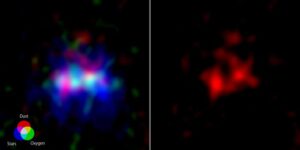
Everything is a cycle. We don’t always know all the parts of the cycle… but our universe truly is wheels within wheels within wheels.
One of the cycles we’ve studied the most is the cycle of star formation. With each generation of stars, we’ve seen our universe get more complex, and more full of possibilities. Stars in all their diversity require different mixes of atoms, and planets… Well, planets require the heavy atoms generated across generations of stars.
While we know that modern stars and the most ancient stars were different, most of our understanding comes from running computer models … which often fail to predict some of the weird and wonderful things our Universe throws at us.
Luckily, telescopes can act as time machines thanks to the finite speed of light.
As I look at my camera, I see how it appeared the smallest fraction of a second ago. When I look – safely through eclipse glasses – at the Sun, I am seeing it as it appeared 8 minutes ago. The further and further away we look, the longer it takes light to travel to us, and thus, the older the light is when it reaches us. When we look at light that has traveled 5 billion light years from a galaxy… we see that galaxy as it appeared 5 billion years ago.
Our best modern time machines are the JWST and ALMA. With its 6.5 meter mirror and location in space, JWST is able to see faint objects whose light came from the early universe. On Earth, ALMA does similar work in even redder colors of light. Together they can capture everything from hot young stars, to cooling gas nebulae.
Case in point: In a new paper in the Astrophysical Journal, researchers led by Yoichi Tamura used ALMA to study star formation when the universe was just 600 million years old, and they were able to resolve features as small as 1000 ly across. That object? MACS0416_Y1.
By looking at the system in the colors of light emitted by dust and by ionized oxygen, the research team could see where hot star formation had started, where cool dust waited to form stars…. And where neither dust nor young stars were hanging out.
They found a hollow region – seemingly carved out by the explosions of young stars, completely surrounded by an intermixed nebula of dust and forming stars. Overtime, the observations indicate the stars will form into massive clusters. The details of how that will happen … well that may be research for the JWST to take on.
As team researcher Takuya Hashimoto explains, these were extremely difficult observations. “It corresponds to capturing the extremely weak light emitted by two fireflies located 3 centimeters apart on the summit of Mount Fuji as seen from Tokyo, and being able to distinguish between those two fireflies.” Tamura adds, “In the future, more detailed information can be obtained by conducting high-resolution observations of these star clusters themselves, using instruments such as the James Webb Space Telescope and the planned Extremely Large Telescopes.”
One of our greatest frustrations in astronomy is that we want to do more science than we have telescopes to do. Projects like looking at MACS0416_Y1 have to wait their turn as everyone proposes for their best projects to get observed.
Reference:
Tamura, Y., Bakx, T.J., Inoue, A.K., Hashimoto, T., Tokuoka, T., Imamura, C., Hatsukade, B., Lee, M.M., Moriwaki, K., Okamoto, T. and Ota, K., 2023. The 300 parsec resolution imaging of az= 8.31 galaxy: Turbulent ionized gas and potential stellar feedback 600 million years after the Big Bang. The Astrophysical Journal. 952 9 10.3847/1538-4357/acd637
